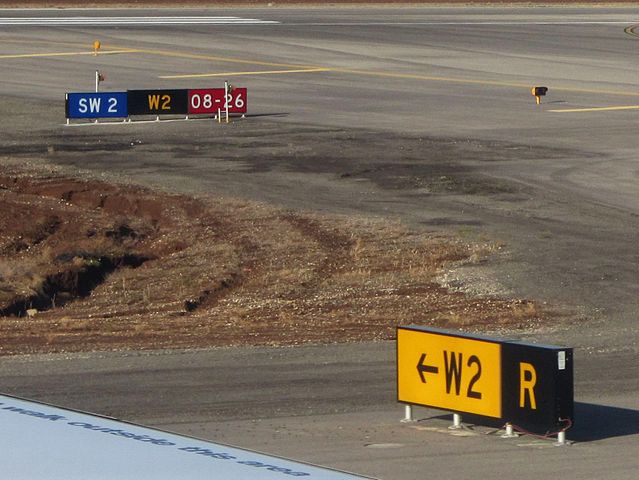Airport Signage and Markings
Scenery / Accuracy Issues
Please be aware that the default scenery or 3rd party sceneries may not be entirely accurate with the posted signage on the ground. However, this guide will explain how to read and understand them.
FAA Quick Reference Guide
The FAA has a handy guide available for download that contains images of all the pertinent signs you may encounter, their purpose, and location at the airport.
There are two types of signage at airports - operational guidance signs and mandatory instruction signs.
Operational Guidance Signs
Location Signs
- These signs are yellow text on a black background. Typically, indicates a specific taxiway or runway your aircraft is on or entering.
Direction/Runway Exit Signs
- Black text on a yellow background. These will have an arrow indicating the direction to turn, which helps pilots identify what taxiways they are approaching or runway exits towards a specified runway.
Stop Bar Signs
- White text on a blue background. These are non-standard signs that may appear at some airports, usually indicating
which taxiway a stop bar is positioned. Airports usually use more conventional traffic signs you may see on the road,
such a regular stop sign. See the FAA Guide for samples.
Mandatory Instruction Signs
Runway Signs
- White text on a red background. These signs inform pilots that a runway intersection is ahead.
Holding Position Signs / Markings
There are typically three very important holding position signs / markings that appear on the ground at airports. At various airports that operate with low visibility, these positions are also paired with a line of red lights across a taxiway to help visually indicate the holding positions.
-
Runway Holding Position
- Two sets of solid yellow lines and two sets of dashed yellow lines indicate a holding position for a runway ahead. These must never be crossed without express permission from ATC.
"Holding position markings pattern A ahead of a crossing runway" by Claudius Henrichs CC BY-SA 2.0
-
Taxiway Holding Position
- Single dashed yellow line. If this is present along your taxi route, it will indicate a position that ground control may request you stop and hold short before another taxiway.
-
ILS Critical Area
- Solid yellow lines that look like a railroad or ladder. These are another form of hold short point but indicate a critical area Where your aircraft would violate the ILS approach airspace while on the ground.
Taxiway Lighting
Taxiway lighting helps the flight crew and ground crew navigate the airport at night or in low visibility and stop at the appropriate locations as given by ATC.
There are usually two types of lighting on taxiways - centerline and edge. Depending on the airport operator, the lightning may differ if the airport operates in low visibility conditions.
- Centerline lighting is green on the principal taxiways located along the taxiway centerline. These lights can alternate between green and yellow when a taxiway crosses a runway, or highlight a "lead-off" taxiway from a runway to join a taxiway.
- Edge lighting is typically blue and characteristically appears at the edges of a taxiway. Spacing can range from 50-200ft apart, usually condensing in distance when approaching an intersection.
John Murphy, CC BY-SA 2.0





